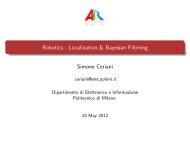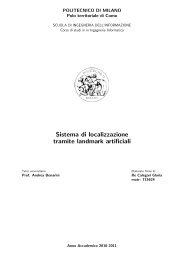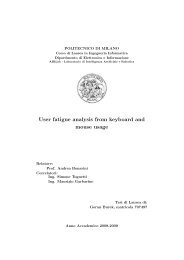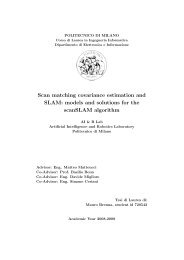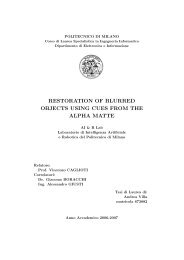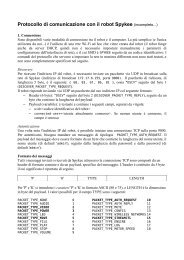Submitted version of the thesis - Airlab, the Artificial Intelligence ...
Submitted version of the thesis - Airlab, the Artificial Intelligence ...
Submitted version of the thesis - Airlab, the Artificial Intelligence ...
Create successful ePaper yourself
Turn your PDF publications into a flip-book with our unique Google optimized e-Paper software.
46 Chapter 4. Control<br />
B.3. The most common used one is <strong>the</strong> mixed angular and linear movement.<br />
Almost every path was initially implemented with this movement approach.<br />
O<strong>the</strong>rs have been used where optimization is needed to cover problems due<br />
to <strong>the</strong> lack <strong>of</strong> encoders to control <strong>the</strong> position <strong>of</strong> <strong>the</strong> motors.<br />
4.3 PWM Control<br />
Motors are controlled by applying a PWM signal to <strong>the</strong> H-Bridges. In order<br />
to control velocity we did not use any encoders, so we don’t have feedback<br />
about<strong>the</strong>motor rotation, or <strong>the</strong>displacement achieved with<strong>the</strong>result<strong>of</strong><strong>the</strong><br />
applied PWM. To have an odometry information without using encoders,<br />
we decided to review and replicate <strong>the</strong> work done at AIRLab about using<br />
<strong>the</strong> mice odometry to get feedback from <strong>the</strong> motors. On <strong>the</strong> previously<br />
work, a set <strong>of</strong> mice were reconfigured to obtain <strong>the</strong> position information,<br />
and calculations were made from <strong>the</strong>se readings to find <strong>the</strong> odometry. The<br />
working configuration was able get a feedback when <strong>the</strong> distance between<br />
<strong>the</strong> mouse sensors and lens was about 1mm, and <strong>the</strong> distance between lens<br />
and ground was also 1 mm, but this distance is too small for our robot. In<br />
order to increase <strong>the</strong> distance to 3 cm which is <strong>the</strong> distance between <strong>the</strong><br />
ground and <strong>the</strong> chassis <strong>of</strong> <strong>the</strong> robot, we experimented changing <strong>the</strong> lens <strong>of</strong><br />
<strong>the</strong> mice.<br />
The mice work like a camera, and <strong>the</strong> image is captured by <strong>the</strong> sensor<br />
inside it through a lens placed in front <strong>of</strong> it. We tested lenses with different<br />
focal lengths and different orientations in order to achieve <strong>the</strong> 3 cm configuration.<br />
During <strong>the</strong> experiments, we obtained different performance on<br />
different grounds and different lighting conditions. We tried several illumination<br />
alternatives, such as laser, led, and table lamp. We were able to find<br />
<strong>the</strong> correct illumination using <strong>the</strong> led with a wave length readable from <strong>the</strong><br />
sensor. And for <strong>the</strong> lens we used a configuration with a focal length <strong>of</strong> 10<br />
mm, leaving <strong>the</strong> distance between <strong>the</strong> lens and <strong>the</strong> sensor at 15 mm and<br />
lens to ground at 30 mm. Instead <strong>of</strong> using encoders that each cost around<br />
50 euro, <strong>the</strong> possible configuration costs around 5 euro, but <strong>the</strong> work is not<br />
finished yet and we decided to include this on <strong>the</strong> robot later.<br />
Since <strong>the</strong>re is no information on <strong>the</strong> motor speed and displacement <strong>of</strong><br />
<strong>the</strong> robot, <strong>the</strong> control process mainly depends on vision, and it is not very<br />
precise. There are situations where we cannot determine whe<strong>the</strong>r <strong>the</strong> motor<br />
is moving. When <strong>the</strong> robot is stuck in a place and <strong>the</strong> sensors do not detect




